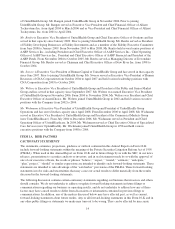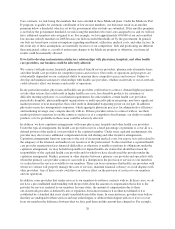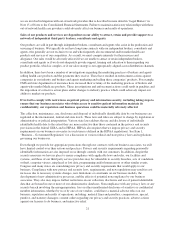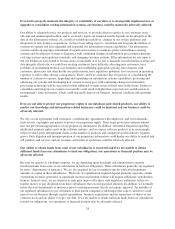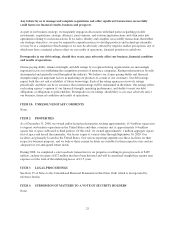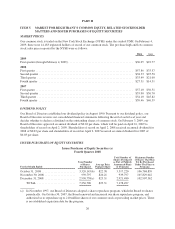United Healthcare 2008 Annual Report Download - page 26
Download and view the complete annual report
Please find page 26 of the 2008 United Healthcare annual report below. You can navigate through the pages in the report by either clicking on the pages listed below, or by using the keyword search tool below to find specific information within the annual report.would fundamentally change the dynamics of our industry, such as having the federal or one or more state
governments assume a larger role in the health care industry or a fundamental restructuring of the Medicare or
Medicaid programs. These proposals may also affect certain aspects of our business, including contracting with
physicians, hospitals and/or other health care professionals; physician reimbursement methods and payment
rates; coverage determinations; mandated benefits; minimum medical expenditures; claim payments and
processing; drug utilization and patient safety efforts; collection, use, disclosure, maintenance and disposal of
individually identifiable health information; personal health records; consumer-driven health plans and health
savings accounts and insurance market reforms; and government-sponsored programs.
For example, the new administration and various congressional leaders have signaled their interest in reducing
payments to private plans offering Medicare Advantage. Depending on the extent and phasing of these potential
reductions, the number of seniors participating in Medicare Advantage and the industry-wide earnings derived
from these plans may fall. In addition, Massachusetts has enacted comprehensive reform, including an individual
health coverage mandate coupled with an employer mandate and a new state connector authority. A number of
other state legislatures, including California, Colorado, New York, Ohio and Pennsylvania, have contemplated
but have not enacted significant reform of their health insurance markets. Other states are expected to consider
these types of reforms as well as more modest reforms aimed at expanding Medicaid and/or SCHIP eligibility as
well as new coverage options for those not eligible for government programs. These proposals include provisions
affecting both public programs and privately financed health insurance arrangements. States also are
considering proposals that would reform the underwriting and marketing practices of individual and group
health insurance products by, for example, placing restrictions on rating and pricing and mandating minimum
medical benefit cost ratios. In addition, from time to time, Congress has considered various forms of managed
care reform legislation which if adopted, could fundamentally alter the treatment of coverage decisions under
ERISA. Additionally, there is legislative interest in modifying ERISA’s preemptive effect on state laws. If
adopted, such limitations could increase our liability exposure and could permit greater state regulation of our
operations.
We cannot predict if any of these initiatives will ultimately become law, or, if enacted, what their terms or the
regulations promulgated pursuant to such laws will be, but their enactment could increase our costs, expose us to
expanded liability and require us to revise the ways in which we conduct business or put us at risk for loss of
business. In addition, our operating results could be adversely affected by such changes even if we correctly
predict their occurrence.
In addition, the health care industry is subject to negative publicity. Negative publicity may result in increased
regulation and legislative review of industry practices, which may further increase our costs of doing business
and adversely affect our profitability by: adversely affecting our ability to market our products and services;
requiring us to change our products and services; or increasing the regulatory burdens under which we operate.
In August 2007, we entered into a multi-state national agreement with regulatory offices in 39 states and the
District of Columbia relating to the legacy UnitedHealthcare fully insured commercial business. The agreement
covers several key areas of review of our business operations, including claims payment accuracy and timeliness,
appeals and grievances resolution timeliness, health care professional network/service, utilization review,
explanation of benefits accuracy, and oversight and due diligence of contracted entities and vendor performance.
The agreement addressed and resolved past regulatory matters related to the areas of review prior to August 2007
and establishes a transparent framework for evaluating and regulating performance through December 2010. On
a prospective basis, the agreement is similar to a customer performance guarantee, whereby we will self report
quarterly and annually our operational performance on a set of national performance standards agreed to by the
participating states. We must perform to the standards set forth in the agreement, or be subject to fines and
penalties.
We are also involved in various governmental investigations, audits and reviews. These regulatory activities
include routine, regular and special investigations, audits and reviews by CMS, state insurance and health and
16










